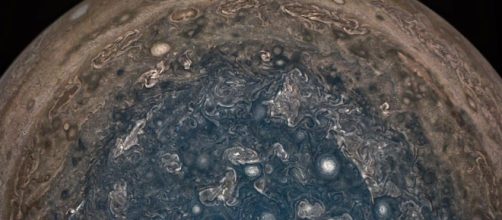Jupiter's great red spot isn't the only storm churning the gas giant's planet. Images from the Juno spacecraft revealed a number of Earth-sized cyclones swirling in Jupiter's south pole. NASA released the stunning images as part of the spacecraft's continued monitoring of the Jovian system.
What causes these immense cyclones in the Solar System?
There are many theories about the formation of this massive cyclone systems but none are definitive. One of the most popular theories is the interaction between Jupiter's strong magnetic field and its atmosphere.
Some scientists also believe that Jupiter is destined to be a star but due to events that happened 4.5 billion years ago, it didn't ignited and became the largest planet in the Solar System.
According to Scott Bolton, principal researcher from the Southwest Research Institute in San Antonio, Jupiter surprised them with the recent atmospheric photographs. He added that due to the images of these multiple cyclones, they had to rethink everything they know about the gas giant.
The Juno spacecraft also discovered that Jupiter's magnetic field is ten times stronger that once believed. It is revealed that the magnetic field of the planet is uneven indicating that the field is created somewhere near the surface.
This information could lead to a better understanding of Jupiter and how massive gas planets are created.
What will be the next objective of the Juno spacecraft?
The Juno spacecraft was launched on 5th August 2011. Its mission is the explore the Jovian system and bring back information about the planet's magnetic field, atmospheric composition and visual observations. After almost four years of travel, the spacecraft reached Jupiter and has since sent back amazing images of the gas planet.
NASA had equipped Juno with eight instruments and a high-definition camera. At the moment, the spacecraft revolves around Jupiter and once every 53 days, it approaches the planet from the north pole. It then transits Jupiter from pole to pole in two hours and shoots back out to space.
On July 11, the Juno spacecraft will fly directly over the famous great red spot, which is a massive cyclone that has been raging from more than three centuries. Until now, little is known about the great red spot, how it was created and why does it remain in one place and not dissipate like storms in our planet. This fly over will yield massive information about the this massive gas planet and may unlock more secrets about this amazing planet.


